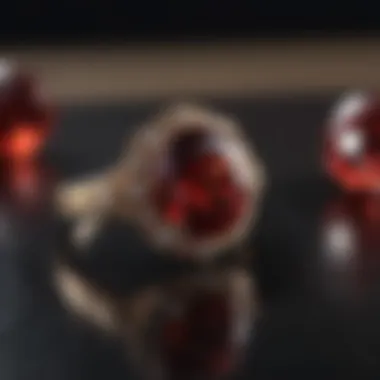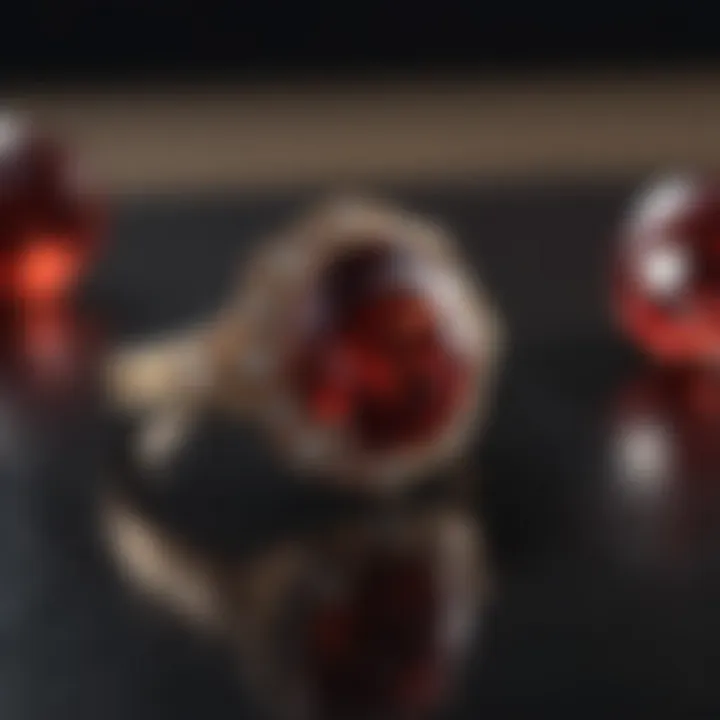Exploring the Richness of Garnet Jewels


Intro
Garnet jewels have a storied place in both history and modern culture, representing not just beauty but also a complex heritage. This article attempts to provide an extensive overview of garnets, including their formation within the earth's crust, the variety of types available, and the rich histories attached to them. It also touches on garnets' applications in today's jewelry landscape and scrutinizes the ethical considerations in their sourcing. Through a thorough examination, readers will appreciate this gemstone beyond its aesthetic value.
Gemstone Overview
Definition and Characteristics
Garnet is a group of silicate minerals, identifiable by their distinctive color and structure. The name "garnet" comes from the Latin word "granatum," meaning seed, owing to the resemblance of garnet crystals to pomegranate seeds. These gemstones display a wide spectrum of colors, including red, green, orange, and purple, and they possess a glassy luster.
Their hardness is noted on the Mohs scale, where garnets typically range from 6.5 to 7.5, making them suitable for various forms of jewelry.
Classification of Gemstones
Garnets belong to the larger category of gemstones, which can be classified based on several criteria. The most common classifications include:
- Natural vs. Synthetic: Natural garnets form through geological processes, while synthetic ones are created in laboratories.
- Precious vs. Semi-Precious: Though all garnets are beautiful, they are often categorized as semi-precious stones.
These classifications help delineate the differences between types of garnets, such as Almandine, Pyrope, Spessartine, and others.
Properties of Gemstones
Physical Properties
Physical properties of garnets encompass several notable features:
- Luster: Garnets exhibit a vitreous luster, allowing light to reflect beautifully off their surfaces.
- Color: Garnets can occur in many colors due to varying trace elements, with red being the most recognized.
- Crystal System: They crystallize in the cubic system, which influences their structure and symmetry.
Chemical Properties
The chemical structure of garnets varies depending on their specific type. Most commonly, garnets are silicates, composed of iron and aluminum among other elements. Their general formula can be represented as A3B2(SiO4)3, where A and B represent different metal ions. This variability in composition is what leads to garnets having unique properties.
In summary, garnets are fascinating jewels that encapsulate both geological history and cultural significance. As this article unfolds, further insights on garnet varieties, historical usage, and their modern implications will be elaborated upon.
Preface to Garnet Jewels
Garnets are one of the oldest gemstones, known for their beauty and varied uses throughout human history. Their importance in the realm of jewelry goes beyond mere aesthetics; garnets carry historical, cultural, and geological significance. This section introduces readers to the concept of garnets, offering insights that enhance their appreciation for the stone. Understanding garnets helps enthusiasts, collectors, and designers appreciate not just their beauty, but also their complexities.
Defining Garnet
Garnet is a term that refers to a group of silicate minerals sharing a similar crystal structure but differing in chemical composition. The most well-known garnet types include almandine, pyrope, and grossular, each possessing unique color variations and physical properties. Garnets are primarily used in jewelry, and their vibrant hues range from deep reds to green and yellow shades.
These gemstones are not just limited to personal adornment; they also serve practical purposes. Historically, garnets find application in abrasives and filtration due to their durability. It is essential to understand the diversity within the garnet family to appreciate their contribution to both art and utility.
Historical Context
The historical usage of garnets dates back thousands of years. Ancient civilizations, including Egyptians and Romans, valued garnets not only for their beauty but also for their supposed protective properties. Garnets were often found in royal tombs, indicating their significance in ancient rituals and beliefs. In many cultures, garnets were associated with life and energy; they were thought to ward off evil and enhance health.
Through the ages, garnets have appeared in royal jewelry across Europe and the Middle East, signifying power and wealth. Their consistent presence in historical artifacts serves as a testament to their enduring appeal and value.
Understanding this context allows modern gemstone enthusiasts to connect with the rich history of garnets and to see them as more than just decorative items, but as vessels of cultural heritage.
Geological Formation of Garnets
The geological formation of garnets plays an essential role in understanding their unique characteristics and value in the gem market. Garnets are not merely decorative stones; they are products of complex geological processes that span thousands of years. Understanding their formation allows enthusiasts and collectors to appreciate the scientific beauty behind them. It also offers insights into the conditions under which these gemstones form, emphasizing their rarity and significance.
Mineralogical Composition
The mineralogical composition of garnets is diverse, comprising a group of silicate minerals with similar crystal structures but varied chemical compositions. The most common garnet varieties include Almandine, Pyrope, and Spessartine, each characterized by specific elements.
- Almandine: Rich in iron, providing a deep red hue.
- Pyrope: Contains magnesium alongside aluminum, typically presenting a bright red color.
- Spessartine: This variety includes manganese, giving it orange to reddish colors.
- Grossular, Uvarovite, and Andradite bring further diversity with their distinct chemical makeups and colors, ranging from green to brown.
The group generally follows the formula [ X_3Y_2(SiO_4)_3 ] where X can be calcium, iron, or magnesium, and Y is typically aluminum, chromium, or iron. Understanding this composition is critical as it influences not just the color but also the durability of the garnets, making some varieties more desirable than others.


Formation Processes
The formation of garnets occurs under specific geological conditions. These minerals primarily crystallize in metamorphic rocks, often in environments where high temperatures and pressures are present. The process begins with existing minerals undergoing metamorphism; as temperature and pressure rise, atoms rearrange to form garnets. This can occur in various settings, such as:
- Contact Metamorphism: Occurs when molten rocks come into contact with surrounding rocks, causing localized heating and recrystallization.
- Regional Metamorphism: Associated with tectonic plate movements. Large areas of rock are subjected to high pressure and temperature over long periods, ideal for garnet formation.
- Hydrothermal Processes: Involve the movement of mineral-rich fluids through rocks, where garnets can precipitate.
The presence of specific elements in the surrounding rocks will influence the garnet's final composition and color. Unique geological conditions can lead to the formation of garnets with exceptional qualities, making them highly sought after by collectors.
Understanding the geological processes behind garnets enhances their value as not just gemstones but as geological records of Earth’s dynamic history.
In summary, the geological formation of garnets provides essential context for their classification and valuation in the gem market. By studying their mineralogical composition and formation processes, enthusiasts can gain a deeper appreciation for these multifaceted jewels.
Varieties of Garnet
The exploration of garnet varieties is essential to understanding the wider significance of these gemstones. Each variety of garnet boasts unique properties, colors, and uses, making them valuable in various contexts from jewelry to healing crystals. Knowledge of these specifics enhances appreciation and informs purchasing decisions for gemstone enthusiasts and collectors.
Almandine
Almandine is perhaps the most recognized type of garnet. It commonly showcases deep red colors, which can sometimes appear almost black. This variety, composed mainly of iron aluminum silicate, is abundant in metamorphic rocks. Almandine garnets are often set in jewelry, where they are prized for their rich colors and brilliance. They can pair beautifully with silver, gold, or platinum. Besides their aesthetic qualities, almandines have a reputation for their grounding properties, thought to enhance confidence and inspire motivation.
Pyrope
Pyrope garnets exhibit a vivid red hue, reminiscent of ruby. They are magnesium aluminum silicates and are typically found in magnesium-rich rocks. One intriguing aspect of pyrope is its color shift under different lighting conditions, which adds to its allure. Often used in jewelry, pyrope garnets symbolize love and passion. Their striking appearance makes them a favored choice in engagement rings and special commemorative pieces.
Spessartine
Spessartine garnets, known for their orange to reddish-orange shades, capture attention with their warm glow. They are manganese aluminum silicates and can be found in granitic and metamorphic environments. This type is somewhat rarer compared to the others. Spessartine garnets are important to artisans and jewelry designers due to their unique colors, frequently used to create artisanal pieces in contemporary designs.
Grossular
Grossular garnets range from pale green to deep red, encompassing a variety of colors including yellow and brown. Comprised mainly of calcium aluminum silicate, they are often associated with metamorphic rocks and are found in deposits worldwide. Their diverse palettes are attractive for gemstone collectors and jewelry enthusiasts alike. Grossular garnets, particularly the green varieties known as tsavorite, are especially sought after and can command high prices in markets due to their rarity and brilliance.
Uvarovite
Uvarovite garnets are unique for their vibrant green hue. They are calcium chromium silicates and typically found in ultramafic rocks. Uvarovite is the rarest of all garnet types, making it a coveted addition to any collection. Its deep green color is reminiscent of emeralds, yet holds distinct characteristics of its own. Collectors often desire this variety for its uniqueness and beauty, as well as its embodiment of prosperity and success.
Andradite
Andradite garnets display a spectrum of colors from yellowish-green to rich brown. They are calcium iron garnets and found in a variety of environments, including metamorphic rocks. The most famous type of andradite is the demantoid, known for its exceptional brilliance and fire. This variety is rare and often more prized among collectors and designers alike. Andradite garnets hold significance for their perceived healing properties, aimed at enhancing inner strength and self-confidence.
"Understanding garnet varieties not only clarifies their geological origins but also deepens the appreciation for their unique contributions to jewelry and metaphysical practices."
The exploration of these distinct garnet varieties underscores their multifaceted applications and desirability among gemstone enthusiasts, collectors, and jewelry designers. The diversity of garnets enriches the gemstone world, providing options that appeal to a range of aesthetics and values.
Cultural Significance of Garnet
Garnet jewels hold much more than mere aesthetic value. They have a profound cultural significance across various societies and time periods. Their use in jewelry and ornamentation signifies status, beauty, and personal expression. Their vibrant hues and distinctive properties have rendered them especially revered as both gemstones and symbols within different cultures. Understanding this significance helps enthusiasts and collectors appreciate garnets beyond their physical allure.
Garnet in Ancient Civilizations
In ancient civilizations, such as Egypt and Greece, garnets were treated with high esteem. Egyptians often adorned themselves with garnet jewelry, believing these stones held protective qualities. Artifacts found in tombs reveal their use in amulets and other funerary items. The Greeks, too, valued garnets, utilizing them for both decorative purposes and as signet stones in rings. They often carried small garnet talismans, seen as aids for courage in battle.
The use of garnet continued through the Roman Empire, where wealthy citizens wore garnet pieces to denote their affluence. The red hue of garnet was often associated with vitality and life. Additionally, garnet was linked to the god of war, Mars, amplifying its significance in various military contexts.
Modern Symbolism


In contemporary contexts, garnet has taken on new meanings. Today, garnets symbolize friendship and trust, making them popular for gifts and special occasions. The deeper meaning attached to garnets resonates with those looking for meaningful jewelry. Jewelers frequently promote garnets as stones of commitment, suitable for engagement rings or anniversary gifts.
The healing attributes often associated with garnets also play a role in their modern symbolism. People believe garnets promote energy and vigor, making them popular among those interested in holistic health and well-being.
In summary, the cultural significance of garnet spans centuries and civilizations, highlighting its enduring allure and multifaceted meanings. From ancient protective amulets to modern symbols of trust and vitality, garnets continue to captivate collectors and enthusiasts alike.
Metaphysical Properties of Garnet
Garnets are not only valued for their physical beauty but also for their metaphysical properties. Gemstone enthusiasts often seek garnets for their perceived ability to provide emotional stability and enhance spirituality. The belief in these properties is deeply rooted in cultures worldwide, which adds an extra layer of significance to this gemstone. Understanding these aspects helps collectors appreciate garnets beyond their aesthetic value, recognizing their importance in holistic practices.
Emotional Healing
Garnets are said to have a powerful influence over our emotional state. They are believed to help individuals release negative energies and foster feelings of love and compassion. This gemstone can stimulate emotional balance and improve self-confidence. Many practitioners recommend garnet for those dealing with grief or trauma, as it is thought to restore emotional equilibrium and inspire a positive outlook.
Some benefits include:
- Encouraging optimism by dispelling negative thought patterns.
- Enhancing emotional intelligence, leading to greater understanding in relationships.
- Providing a sense of security necessary for personal growth.
In meditation, garnets are often placed on the heart chakra to help individuals access and release deep-seated emotions. This practice is considered essential for emotional transformation.
Physical Well-being
In terms of physical health, garnets are associated with various benefits. They are often seen as a source of vitality and energy. Some proponents believe garnets can enhance overall physical health by stimulating the body's restorative processes. This belief is tied to the color and vibrancy of the garnet itself.
Notable effects claimed by enthusiasts include:
- Boosting circulation, leading to increased energy levels.
- Stimulating metabolism, which may support weight management.
- Strengthening the immune system, thereby aiding in recovery from illness.
While scientific evidence is limited, many people report positive changes when incorporating garnets into their wellness routines.
Spiritual Insights
On a spiritual level, garnets are believed to deepen one's connection to the divine and enhance intuition. Many spiritual seekers utilize garnet in their practices to facilitate self-discovery and personal growth. This gemstone is also thought to heighten awareness and inspire creativity, making it beneficial for artists and writers.
The key spiritual attributes include:
- Fostering greater self-awareness, leading to a deeper understanding of one’s life path.
- Encouraging spiritual awakening through meaningful meditation practices.
- Promoting grounding, helping individuals stay connected to the earth while exploring spiritual realms.
Using garnets in rituals or as a talisman may enhance one’s spiritual experiences, leading to insights that promote personal evolution.
"Garnets are not just beautiful gems; they embody the potential for transformation in both emotional and spiritual dimensions."
Applications of Garnet in Jewelry
Garnet jewels hold a special place in the world of jewelry design. Their varied colors and unique properties make them suitable for numerous applications. Garnets are not just simple adornments; they are stones imbued with rich meanings and significant value. This section will explore the recent design trends tied to garnet jewels and the ethical considerations surrounding their sourcing.
Design Trends
In recent years, the jewelry industry has seen a resurgence in the use of garnet stones. Designers are increasingly incorporating garnets into various types of jewelry. Their rich colors range from deep reds to vibrant greens, appealing to a wide range of aesthetic preferences.
- Statement Pieces: Garnets are often used to create bold, statement pieces. They draw attention and can serve as the focal point of an outfit.
- Mixed Media: Combining garnets with other gemstones and metals like gold or silver creates layered visual textures. This attracts a contemporary audience.
- Nature-Inspired Designs: Many designers are embracing organic forms. Garnets are used to enhance designs inspired by nature, such as floral motifs and natural landscapes.
The adaptability of garnets allows for various styles, from classic to modern. As tastes continue to evolve, garnets are likely to remain relevant due to their versatile applications in both casual and formal jewelry.
Ethical Considerations in Sourcing


With the rise of conscious consumerism, ethical considerations are becoming increasingly important in the jewelry industry. Sourcing garnets requires careful attention to the origins of these stones.
- Transparency: Consumers now demand transparency in the sourcing process. They want assurance that their garnets are sourced from reputable mines that adhere to ethical labor practices.
- Fair Trade Practices: Some companies promote fair trade sourcing. This ensures that miners receive fair wages and labor conditions, making a significant difference in their communities.
- Environmental Sustainability: Ethical sourcing also involves considering the environmental impact of mining practices. Sustainable methods that minimize ecological damage are now preferred.
In summary, garnet jewelry applications are multifaceted. Emphasizing design trends can keep the aesthetic fresh and engaging. Meanwhile, ethical sourcing considerations ensure that the appreciation for garnets extends beyond mere beauty, encapsulating values of fairness and sustainability.
"The integration of ethical considerations in gem sourcing reflects a growing trend toward sustainability in luxury markets."
Increasingly, gemstone enthusiasts, collectors, and designers are viewing garnets not just for their beauty but also for the stories they tell and the ethical implications behind them.
Garnet Care and Maintenance
Caring for garnet jewels is essential not only to maintain their aesthetic charm but also to preserve their intrinsic value. Understanding proper care techniques can extend the lifespan of garnet pieces. Jewelry holds sentimental value for many, and garnets, with their rich colors and historical context, are no exception. Thus, incorporating effective care and maintenance can enhance the enjoyment of these gemstones for years.
Cleaning Techniques
Cleaning garnet jewelry requires a gentle approach to avoid damage. Here are some effective methods:
- Warm Soapy Water: Mixing mild soap with warm water is a simple yet effective way to clean garnets. Soak the jewelry for a short time, then gently clean using a soft cloth or a soft brush.
- Avoid Harsh Chemicals: It is crucial to stay away from abrasive cleaners and chemicals. Substances like bleach can damage gemstones and settings.
- Rinse Thoroughly: Always rinse garnet pieces with clean water after washing to remove any soap residue. This step helps to maintain the brilliance of the garnet.
- Dry with Care: Use a soft, lint-free cloth to dry the jewelry thoroughly. Avoid using paper towels or similar materials that may scratch the surface.
"Proper cleaning techniques can significantly enhance the sparkle and appearance of garnet jewelry while ensuring its durability."
Storage Recommendations
Storing garnet jewelry correctly is a fundamental practice in gemstone care. Here are some useful tips to consider:
- Separate Storage: Store garnets separately to prevent them from scratching other jewelry pieces. Use fabric pouches or individual compartments in jewelry boxes.
- Avoid Extreme Temperatures: Keep garnet jewelry away from extreme temperatures and direct sunlight. High temperatures can affect the stone’s coloration.
- Humidity Control: Store in a climate-controlled environment to prevent humidity buildup. Excess humidity may damage the metal settings.
- Regular Inspection: Periodically check for any loose stones or damage. Early detection of issues allows for timely repairs, enhancing the longevity of the piece.
By following these care techniques, gemstone enthusiasts can ensure that their garnet jewelry remains vibrant and valuable. These practices contribute to a deeper appreciation of these multifaceted gems.
The Future of Garnet Jewel Collecting
The future of garnet jewel collecting presents a fascinating intersection of market dynamics, evolving consumer preferences, and the sustainable sourcing of gemstones. As collectors grow increasingly discerning about their acquisitions, the focus has gradually shifted towards not just the aesthetic appeal of garnets but also their provenance and impact on the environment. These shifts underline the importance of understanding market trends and potential investment opportunities in this unique sphere.
Market Trends
Currently, garnet jewels are witnessing a revival in popularity. More collectors are integrating garnets into their collections, motivated by the stone's diverse variety and rich history. Online platforms have made these gems more accessible, fostering a community of enthusiasts who share insights and trends. Interest in garnets is also driven by a growing appreciation for unique and lesser-known gemstones among consumers who seek to stand out in their personal style.
The rise of sustainable jewelry has influenced market dynamics. Buyers are increasingly looking for ethically sourced garnets. This has led to an uptick in demand for reputable suppliers who can demonstrate transparent sourcing methods. The market now values companies that adhere to ethical practices.
Another notable trend is the increasing fusion of technology with gem collecting. Digital platforms allow consumers to verify the authenticity and quality of garnets before purchase. Moreover, employing augmented reality applications, potential buyers can visualize how garnet jewelry will look in real life, enhancing their shopping experience.
"The garnet market reflects broader social changes. Collectors are not just buying gems but investing in ethical narratives."
Investment Potential
Investing in garnet jewels offers varied opportunities. With some garnet types being relatively rare, unique pieces have the potential for significant appreciation over time. For instance, Spessartine garnets with vivid orange hues are becoming particularly sought after, often fetching higher prices in auctions. Furthermore, with a growing collector base, early investments can prove advantageous as demand is likely to increase.
However, potential investors should exercise caution. Understanding the specific traits of garnets, such as their clarity, cut, and color, is critical in determining their market value. Established market experts recommend working with reputable gemologists for valuations, as well as thoroughly researching the particular type of garnet. Investing in garnets should also consider market volatility and changing consumer preferences.
Ultimately, garnet jewel collecting can serve not just as a passion but as a viable investment strategy, rewarding those who approach it with knowledge and care.
Epilogue
The conclusion of this article embodies the culmination of understanding garnet jewels through various lenses. Essential aspects like geological formation, cultural significance, and ethical sourcing practices allow for a holistic view of these gemstones. Recognizing garnets as not only aesthetic objects but also as indicators of ethical practices in the jewelry industry offers groundwork for informed consumption. This knowledge holds substantial benefits for both casual enthusiasts and serious collectors, highlighting the importance of thoughtful consideration in purchasing decisions.
Summary of Insights
Garnets encompass a diverse range of colors and varieties and possess a long-standing history intertwined with human civilization. Each subtype, whether almandine or spessartine, brings a unique appeal and significance. This article has meticulously examined the geological composition of garnets, outlined specific varieties, and discussed their cultural relevance across time. Moreover, the metaphysical properties associated with garnets provide an avenue for emotional and spiritual exploration, deepening their allure.
Understanding maintenance and care for garnet jewels ensures that they remain vibrant and appreciated for years to come. These facets enrich the narrative surrounding garnets, making them timeless additions to any collection.
Implications for Gemstone Enthusiasts
For gemstone enthusiasts and collectors, the implications of this gathered knowledge are manifold. Insight into the origins and ethical sourcing raises awareness of responsible buying, fostering a greater connection to the items collected. Potential investment opportunities are also evident, as historically significant and ethically sourced garnets may increase in value over time.
It’s essential to engage with garents beyond their visual appeal. By comprehending their historical and cultural significance, one can cultivate a deeper respect for these gemstones. Enthusiasts can thus advocate for ethical practices within the gem industry, promoting better standards for sourcing and production.



